Tips for Shopping Success at the Farmers’ Markets
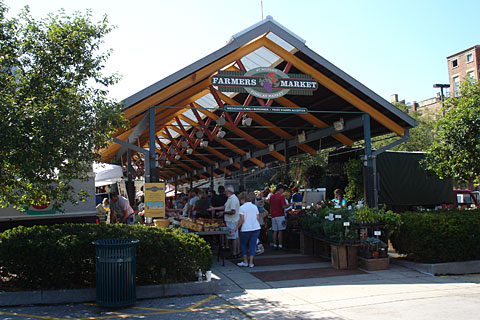
This warm, mid-April finds me an extra happy camper. Not only is my Spring garden off to an early, robust start, but the coming weekend also signals the beginning of farmers’ market season (the first of my regular stops, the Bellevue Market in Northern Kentucky, opens Saturday.)
Oh, fresh, snappy Greens, I have missed you so much.
It’s one of the greatest joys of summer weekends, hitting the farmers’ markets on Saturday and Sunday mornings. I’m a contented Midwestern girl, and I don’t envy folks on the coasts … except for their year-round access to greenmarkets. Here in Ohio, open-air market season is still primarily summers-only, although farmers are doing their best to reasonably extend the season at both ends.
The long stretch of winter and absence of markets really does make the heart grow fonder, however, and by March — after months of brown food — you’ll find me keeping constant vigil on the local news, waiting to hear when the markets will open for the season. Cincinnati, like many cities, experienced an explosion of farmers’ markets in recent years, and we have not one or two, but over a dozen significantly-sized shopping options throughout the week, in locations all over the city. If you live in Cincinnati, you’re less than 15 minutes away from a farmers’ market.
And, in general, more Americans now have direct access to locally raised produce and meat than at any time in the last 50 years. And it’s all thanks to the farmers’ market.
You might be a veteran shopper, like myself, or completely new to the scene. Either way, it’s a completely different experience from the grocery store. I’ve compiled some tips to help everyone get the most out of the coming season. Hope you find them useful!
First, think about what you want/expect from a farmers’ market and the goals you have for shopping there.
It’s an extra stop for most people and in these busy times, you’ll want to have your goal firmly in mind. I, for example, grow much — but not all — of my own produce, so I shop farmers’ markets to buy what I don’t have the space to grow (such as summer squash, pumpkins, corn) and to supplement my own organic crops when production lags.
Other examples of goals and expectations:
- You want to purchase all or most of your produce from a local source.
- You want a reliable source for organic produce.
- You want to support growers/producers in your community (tip: obtain a list of the vendors and their locations to ensure they’re actually in your community. Some vendors will drive long distances to set up at popular markets. They’re still regional and better than cross-country, but you want to make sure the market matches your goals)
- You want to know where your food comes from and know the farmer who produces it, look him in the eye.
Next, find a farmers’ market near you
For the major U.S. cities (NYC, San Francisco) who have large markets on just about every block — some operating year round — count your blessings. The rest of us have to do some research.
Keep an eye on your city’s local newspaper/web site for announcements, or visit http://www.localharvest.org/, which maintains a fairly comprehensive list of farmers’ markets, searchable by state or zip.
Once you find the names and locations of greenmarkets near you, research them on the Internet — most have web sites with basic info, including mission statements, operating hours, the list of participating vendors, and contact info for the market manager.
If you have specific requirements in mind, you’ll want to look up the rules concerning vendor participation. For example, if you’re looking for organic produce, find out whether a market requires organic certification or a statement of organic practices in order for a vendor to sell at the market. Some markets are all-organic, some are not. You can also check to determine whether the market personnel actually inspects the farms annually (preferably in cooperation with the local department of health). It’s sad to think about it, but farmers’ markets are prone to cons and scams the same as any other organization.
Stay in touch
If the market puts out a newsletter — usually an email newsletter — sign up for it. Market managers want to keep their customers engaged and therefore publish regularly. Each edition will often include a list of what each vendor plans to bring to the market that week. You’ll also be the first to hear about market news and special family events.
Make friends
When you find a market you like, make the effort to get to know the farmers and producers. It’s an amazing opportunity to be able to look the producer of your food right in the eye, smile and shake their hand. Introduce yourself and learn their names. Ask if they’re on Facebook or Twitter, and follow them if they are. Many producers hold family-oriented events on their farms, or provide pick-your-own opportunities in their fields. It’s the best, most beneficial buyer-seller relationship you’ll ever have.
Know the season
Keep handy the in-season growing schedule for your harvest zone (http://www.fieldtoplate.com/guide.php). Being aware of what produce will be arriving at your market in the next week or two will help you plan your menus as well as keep expectations reasonable (in other words, know that your caramel apple pie craving will have to hold on until September, when fresh apples first appear in the local markets).
Make a shopping list … but also keep an open mind
I can tell you from exasperating personal experience that it’s easy to get caught up in the moment, taking in the sights of all of the beautiful produce, chatting with the farmers … and completely forgetting the cucumbers you expressly went to the market to purchase.
On the other hand, Mother Nature is temperamental, and the weather directly impacts what will appear at the market on any given day. Perhaps Wednesday’s newsletter said eggplant will be at the Saturday market, but then Friday’s storms and crop-breaking wind-shear decided otherwise, leaving potatoes and zucchini as your best options. Flexibility can lead to wonderful discoveries.
It’s Not Just About Plants Anymore
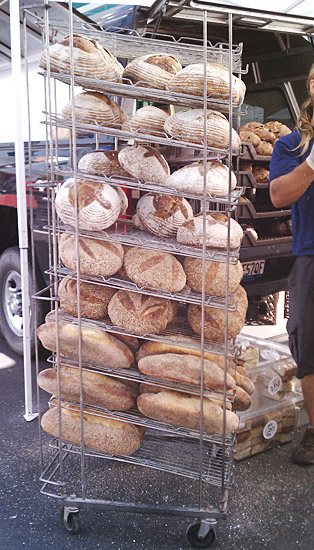 As if the win-win of locally-grown, freshly-picked produce wasn’t enough, the artisan food movement has found a happy home at the greenmarkets, right along side their farming colleagues. The markets in my area sell an amazing assortment of cottage industry products, including artisan breads and pastries, cheeses, jams, jellies, vinaigrettes, pastas, fermented products (kimchi, kvass, kombucha), dairy products, gelato, honey, maple syrup, and even teas, coffee and olive oil. This is the part where keeping an open mind comes in really handy: you just never know what you’re going to find.
As if the win-win of locally-grown, freshly-picked produce wasn’t enough, the artisan food movement has found a happy home at the greenmarkets, right along side their farming colleagues. The markets in my area sell an amazing assortment of cottage industry products, including artisan breads and pastries, cheeses, jams, jellies, vinaigrettes, pastas, fermented products (kimchi, kvass, kombucha), dairy products, gelato, honey, maple syrup, and even teas, coffee and olive oil. This is the part where keeping an open mind comes in really handy: you just never know what you’re going to find.
Be a savvy shopper of fresh produce
This goes far beyond squeezing the avocado or sniffing the melon stem. Americans need to relearn what non-industrial fruit and vegetables actually look and feel like when they’re freshly ripe and ready to eat.
- Bigger is not necessarily better. Leave the American consumer mentality behind and shop produce-centric. Many fruits and vegetables are at their tastiest when they’re smallish. Strawberries, radishes, cucumbers, carrots, summer squash, and leafy salad greens for example, turn tough and bitter as they overgrow their optimal size. A large cucumber with a yellow patch (indicating it’s been on the vine too long) will not be nearly as sweet and flavorful as its smaller all-green counterpart. (Note that this doesn’t mean that all large cucumbers are not tasty — some varieties are meant to be large and will be flavorful at that size. But even large produce can overgrow).
- The most beautiful tomato on the table is not guaranteed to be the best tasting. Grocery store displays of perfectly formed, uniformly colored, uncracked tomatoes is a manufactured visage perpetuated by industrial agriculture, playing on Americans’ obsessions with beauty and aesthetics.
The best tasting tomatoes in the world are heirloom varieties (try Brandywine, Cherokee Purple, Black Krim, Black Cherry, Sungold Cherry), but these crazy-wonderful little bastards grow in every shape and size except “uniform.” Leave your expectations in the car, and try the gorgeous, perfectly-imperfect heirlooms. (By the way, small cracks around the stem of a tomato do not signal disease. It simply means that there was a hiccup in their watering schedule early in their growth cycle — say, a skipped day of watering because the forecast had called for rain that never came through. That’s all, nothing more.)
- Dirt is not a bad thing. Don’t reject a dusty potato because it’s dusty. That’s how they come out of the ground! Because organic produce is not treated with preservatives or waxes upon harvesting (which keeps produce looking bright and unnaturally shiny during cross-country transport — think apples), the coating of dirt will help protect the vegetables from exposure to heat, sunshine and air (which can start oxidation in some produce).
- Related to the note above, you should always, always thoroughly wash your produce before you use it, regardless of whether the farmer washed it before market, or whether it’s organically grown. Lots of unappetizing things can happen to a carrot between its emergence from the ground and its arrival on your cutting board.
- Be wary of out-of-season, stickered or pre-packaged/sealed produce, and never hesitate to ask questions of the vendor (or even the market manager). Not a month goes by when I don’t see an unfamiliar vendor suddenly pop-up at some market selling produce marked with SKU stickers. I’m a lifelong gardener, and I can testify that no onion comes out of the ground fitted with a SKU sticker. Farmers generally harvest their goods the night before or the morning of a market sale. They not only don’t have time to SKU their goods, they have no need for that kind of inventory tracking and pricing. If something about the set up looks fishy, it probably is. Alert the market staff. Similarly, if you see, say, pumpkins in June, ask the vendor where they came from, since odds are, they didn’t come from the U.S. (much less a local, non-industrial farm).
- If you’re thinking about doing some bulk preserving, don’t hesitate to talk to the farmers about placing a large order. In my area, strawberries and blueberries are highly-prized items and sell out quickly at the markets. So quickly, in fact, that when I do preserving of any kind, I make arrangements to go directly to the farm, as the meager pint or three of berry goodies that I can wrangle in my market bag aren’t nearly enough. Sometimes the farmer will even bring your special order to the market with them, saving you a trip out to the countryside.
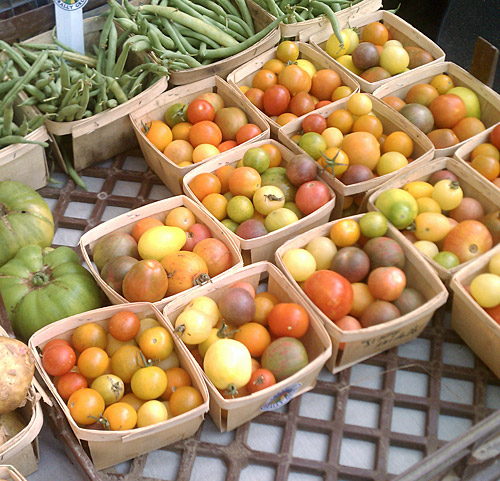
Other tidbits
- Bring sturdy, reusable, comfortable-to-carry-or-wear shopping bags to the market. Most vendors come prepared with a supply of bags, however, they’ll appreciate not having to use their stash. And in addition to being appropriately eco-friendly at (ahem) greenmarkets, they’re also quite practical. Watermelons, cantaloupes, squash and jam jars can become heavy and unwieldy very, very quickly, and you’ll be glad for the shoulder bag as you continue to walk the market with your haul.
- If you’re bringing small children with you, don’t forget the stroller. Unlike the grocery store, you’re carrying all of your purchases on your person, so when your child tires of walking, you’ll be carrying them, too. Watermelon in right arm + bag of tomatoes looped over right wrist + 3-year-old in left arm = one tired mama. Plus, a toddler strapped in a stroller prevents that wandering-off-in-a-bustling-crowd thing that’s the nightmare of every parent.
- Most markets are animal-friendly. Check your market’s rules and, if permitted, feel free to bring Fido. Keep your furry friend on a short leash at all times, and if the animal becomes agitated due to the crowd or the presence of another animal, leave the scene immediately. I’ve been witness to a number of unfortunate incidents that ended in bites (from the dog) and nose-to-nose shouting matches (between humans).
- Farmers’ markets are definitely family-friendly, and most arrange for musical entertainment, plus the occasional petting zoo and fun and games for the kiddies. Bring the family; let your children learn what it means to grow healthy food for the community. The world will be a better place for it, and it might spark a life’s passion early on.
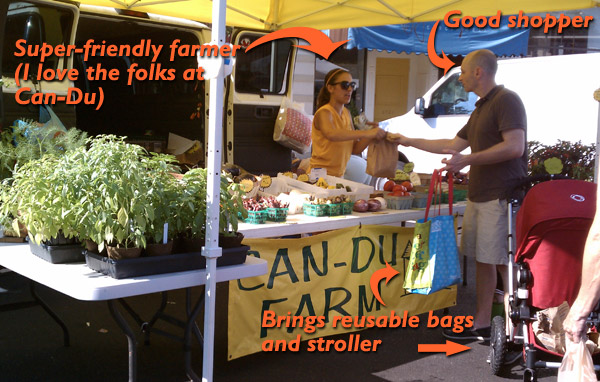
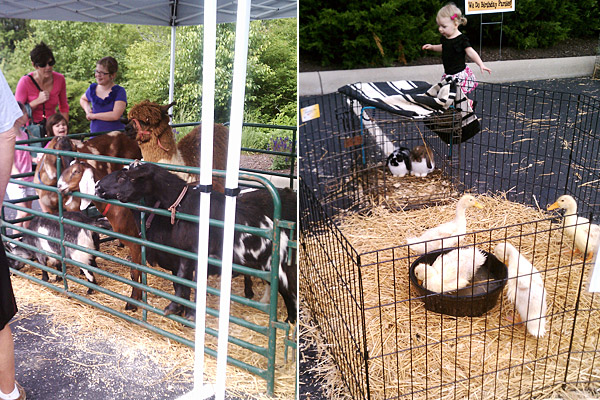

Comments:
Trackbacks & Pingbacks
Comments are closed.








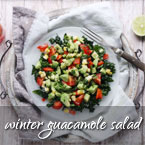



This is a great post. Unfortunately, the farmer’s markets near me are only open while I am at work. 45 minutes away. Sigh. You would think that since I live in an area SURROUNDED by farms that I woudl have better access…
However, I did sign up for a CSA share at a farm near my office & am totally psyched
“but these crazy-wonderful little bastards grow in every shape and size except ‘uniform.’ ” Quote. Of. The. Day.
We are still a ways away from our Farmer’s Market opening. Our market is rather small, but I like it that way. I know almost all of the suppliers and farmers. If they sell it there, I buy it! Yeah Summer!
Great post. Even an old timer like me learned a few pointers…